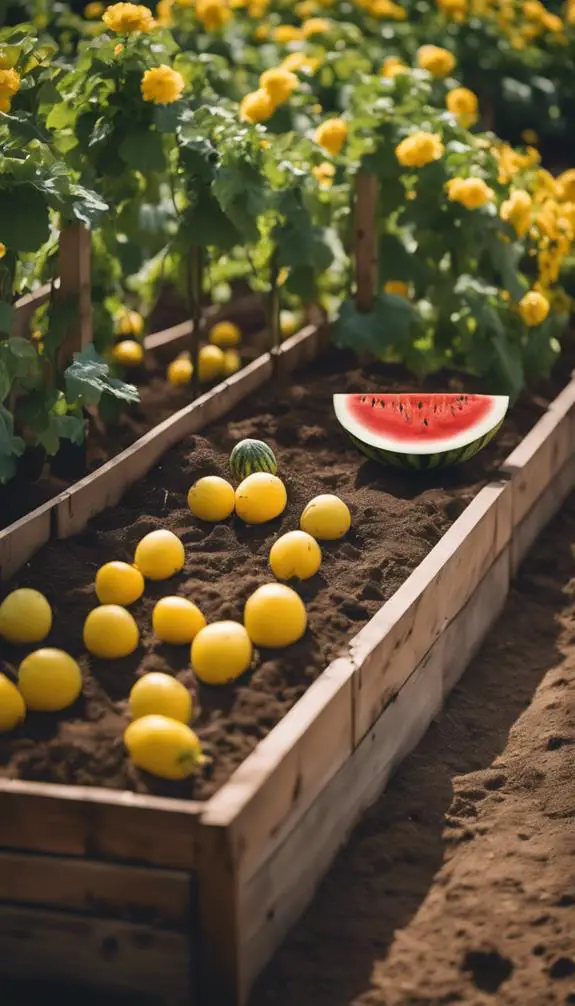As you envision your ideal succulent rock garden, you're likely thinking about more than just plopping a few plants into a decorative bowl. You want a visually stunning oasis that showcases the unique beauty of these low-maintenance wonders. To get started, consider the perfect blend of textures, colors, and shapes that will bring your design to life. But that's just the beginning – with endless possibilities for rock and gravel combinations, container designs, and even vertical installations, the real question is: what kind of succulent rock garden will you create, and how will you make it truly unforgettable?
Succulent Selection and Placement
How carefully do you want to curate your succulent rock garden's aesthetic?
Succulent selection is vital in creating a visually appealing arrangement. Choose a mix of textures, colors, and shapes to add depth and interest.
Consider the growth habits and mature sizes of each succulent to guarantee a harmonious arrangement. Select a focal point, like a striking Echeveria or a statuesque Agave, and balance it with smaller, more delicate species.
Succulent arrangement is an art that requires patience and experimentation. Play with different compositions until you achieve a look that resonates with your personal style.
Remember to leave enough space for growth and air circulation to guarantee the health and longevity of your succulents.
Rock and Gravel Choices

Three essential components of a succulent rock garden are rocks, gravel, and sand.
You'll want to choose rocks that complement your succulents' shapes and colors. Consider Rock Types like granite, basalt, or limestone, which provide a natural, rustic look.
Gravel Colors can also enhance the overall aesthetic. Opt for neutral shades like gray, beige, or white to let your succulents take center stage. Alternatively, bold colors like red or black can create a striking contrast.
When selecting gravel, guarantee it's compactable to prevent settling and promote good drainage. A mix of fine and coarse gravel will help retain moisture while preventing waterlogging.
Container Options and Designs
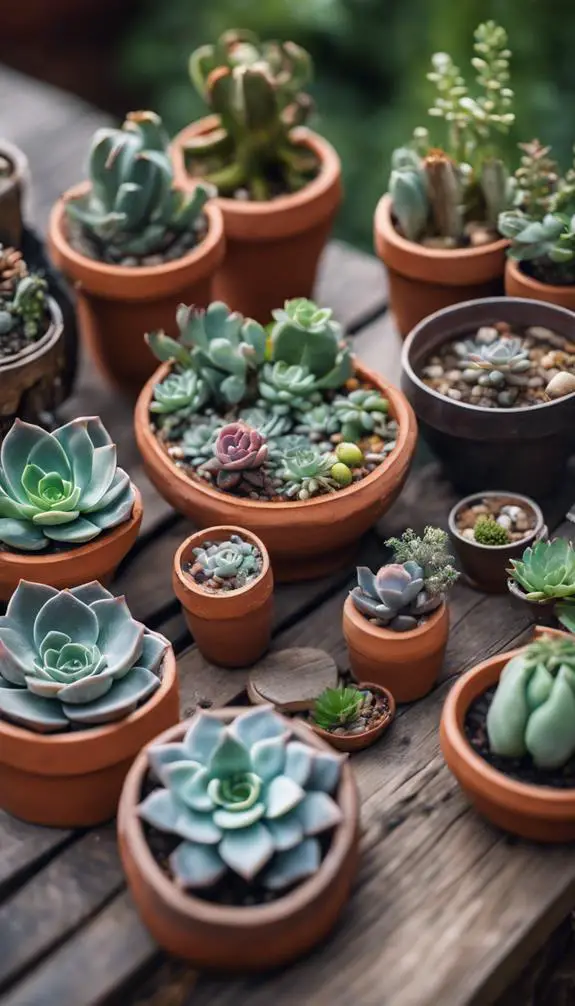
You'll find a world of possibilities in rocky planters, from natural stone to concrete and ceramic options, each offering a unique aesthetic for your succulent rock garden.
Unique vessel choices, such as antique boots or wooden planters, can add a touch of whimsy to your design.
When selecting a container, consider creative pot designs that incorporate built-in drainage systems or elevated planting beds to optimize soil health and visual appeal.
Rocky Planters Galore
As you venture into creating a succulent rock garden, selecting the right planters becomes a crucial step in bringing your vision to life.
You'll want to choose planters that complement your succulents' unique shapes and textures. Consider planters with rocky accents, such as rough-hewn stone or weathered wood, to create a harmonious blend of natural elements.
You can opt for planters with a modern, sleek design or go for a more rustic, distressed look. Mix and match different planter styles to create visual interest and depth in your garden.
Look for planters with good drainage holes to guarantee your succulents thrive. By selecting the right planters, you'll be well on your way to creating a stunning succulent rock garden that showcases your creativity and style.
Unique Vessel Choices
The vessel itself becomes a focal point in your succulent rock garden, and selecting unique containers can elevate the overall aesthetic.
You can repurpose vintage planters, such as old boots, tea cups, or wooden crates, to add a touch of whimsy to your design. Unusual containers like seashells, driftwood, or geodes can also bring an element of surprise.
Consider using industrial materials like metal pipes, concrete, or reclaimed wood to create a modern, edgy look. By choosing unique vessels, you can create a visually appealing contrast between the rough, rocky terrain and the soft, delicate succulents.
This thoughtful selection will draw the eye to specific areas of your garden, creating a dynamic visual experience.
Creative Pot Designs
Every succulent rock garden deserves a statement piece, and creative pot designs can be that showstopper.
You can choose from a variety of pottery styles, each with its unique characteristics, to create a visually appealing arrangement.
Consider ceramic accents like geometric patterns, organic shapes, or bold colors to add an extra layer of depth to your design.
For a modern look, opt for sleek, minimalist planters with clean lines and a monochromatic color scheme.
To add a touch of whimsy, select pots with playful, hand-painted designs or unusual shapes.
Whatever style you choose, make sure it complements your succulents and enhances the overall aesthetic of your rock garden.
Small Space Succulent Gardens
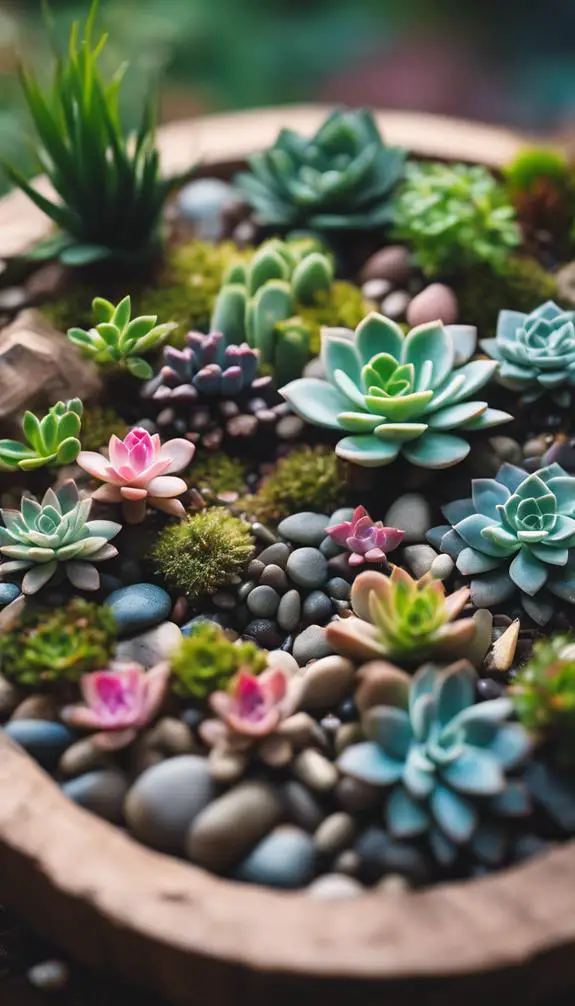
Flexibility is the hallmark of small space succulent gardens, where creativity meets constraint.
You'll need to adapt to space constraints, maximizing every inch of your small garden. Consider a symmetrical design, using identical pots and plants to create a sense of harmony.
Alternatively, use a mix of small pots in varying shapes and sizes to add visual interest. In small gardens, every element counts, so choose succulents with unique textures, colors, and shapes to create a visually appealing arrangement.
Don't forget to leave some negative space to avoid clutter and create a sense of breathability. By embracing the challenges of small space gardening, you'll discover the beauty of simplicity and restraint.
Vertical Succulent Rock Walls

As you design your vertical succulent rock wall, you'll need to ponder the rock face's layout, from staggered stone patterns to uniform grids, to create a visually striking backdrop for your plants.
Next, you'll want to master the techniques for planting succulents in vertical spaces, ensuring each plant is securely anchored and receives adequate water and nutrients.
Rock Face Design Options
When designing a vertical succulent rock wall, you'll want to ponder the rock face's visual appeal, as it sets the tone for the entire installation.
To create a striking rock face, consider the arrangement of rock formations, such as ledges, crevices, and overhangs. These features won't only add depth but also provide pockets for succulents to thrive.
Stone textures play a vital role in the overall aesthetic, with options ranging from rough, porous rocks to smooth, glossy stones. You can mix and match textures to create a visually appealing contrast or opt for a uniform look.
Succulent Planting Techniques
With your rock face design in place, you're ready to bring your succulent arrangement to life.
Start by preparing the soil, mixing a blend specifically designed for cacti and succulents with added organic matter for improved drainage.
Next, gently remove the succulents from their pots, taking care not to damage their roots. Plant them in the crevices and pockets of the rock face, leaving enough space for growth and air circulation.
Secure the plants with a thin layer of soil or a soil-soilless mix, gently firming it around the roots. As you plant, consider the succulent care requirements, such as sunlight and watering needs, to guarantee a thriving vertical garden.
Wall Maintenance Essentials
You've invested time and effort into creating a stunning succulent rock garden, and now it's essential to maintain it properly to guarantee its longevity and aesthetic appeal.
Regular wall cleaning is pivotal to prevent dirt buildup, which can damage your succulents. Use a soft-bristled brush or a gentle spray of water to remove debris.
Additionally, perform drainage checks to confirm water flows freely through the wall's crevices. Clogged drainage can lead to root rot and other issues.
Inspect the wall's backing material and drainage channels for signs of blockage, and clear any obstructions you find. By staying on top of wall maintenance, you'll keep your succulent rock garden flourishing and visually striking.
Colorful Succulent Combinations

This vibrant ensemble of succulents showcases an artistic blend of shapes, sizes, and hues, creating a mesmerizing visual display.
When combining succulents, you'll want to experiment with vibrant palettes that pop against the neutral tones of rocks and soil.
Harmonious contrasts are key to creating a visually stunning arrangement. Pair soft, pastel-hued echeverias with bold, bright aloe vera for a striking contrast.
Alternatively, combine succulents with similar shapes but varying sizes, like small, round sedums alongside larger, spherical euphorbias.
Desert-Inspired Succulent Landscapes
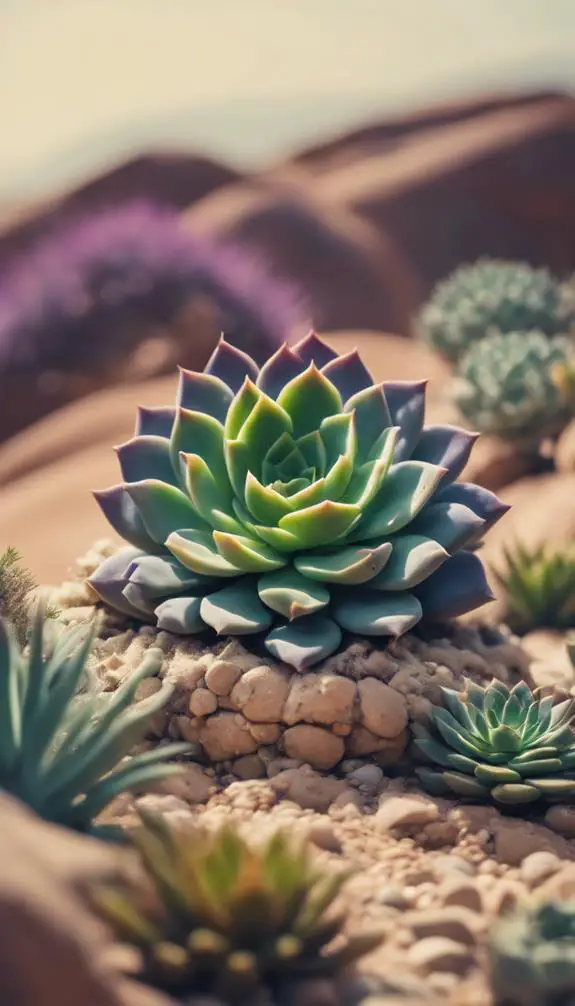
You're about to create a desert-inspired succulent landscape that echoes the arid beauty of the American Southwest.
To start, consider incorporating dry riverbed designs that mimic the serpentine paths of waterless streams, using a combination of rocks, gravel, and strategically placed succulents.
Next, add rocky terrain accents, such as boulders or smaller stones, to create a visually striking topography that underscores the drought-tolerant nature of your succulent selection.
Dry Riverbed Designs
Beyond the arid expanse of a desert landscape, a dry riverbed design can evoke a sense of rugged beauty in your succulent rock garden.
You'll create a visually striking feature by incorporating river pebbles, which mimic the natural flow of water. To add an extra layer of realism, consider incorporating water features, such as a small trickle or a shallow pool, to create a sense of movement.
This design element won't only enhance the aesthetic appeal of your garden but also provide a soothing, peaceful atmosphere. By cleverly arranging the pebbles and water features, you'll create a dry riverbed that appears as if it's been carved out by the forces of nature.
Rocky Terrain Accents
As you design your desert-inspired succulent landscape, incorporating rocky terrain accents can add a striking level of realism.
You can create a visually appealing arrangement by grouping boulders of varying sizes and shapes to mimic natural rock formations.
Consider placing larger boulders towards the back of the landscape, gradually decreasing in size towards the front.
This will create a sense of depth and dimensionality.
You can also use smaller rocks and pebbles to fill in gaps and create a cohesive look.
To add texture and interest, incorporate different types of rocks, such as granite, sandstone, or limestone, and arrange them in a way that suggests natural erosion.
Coastal Succulent Rock Gardens
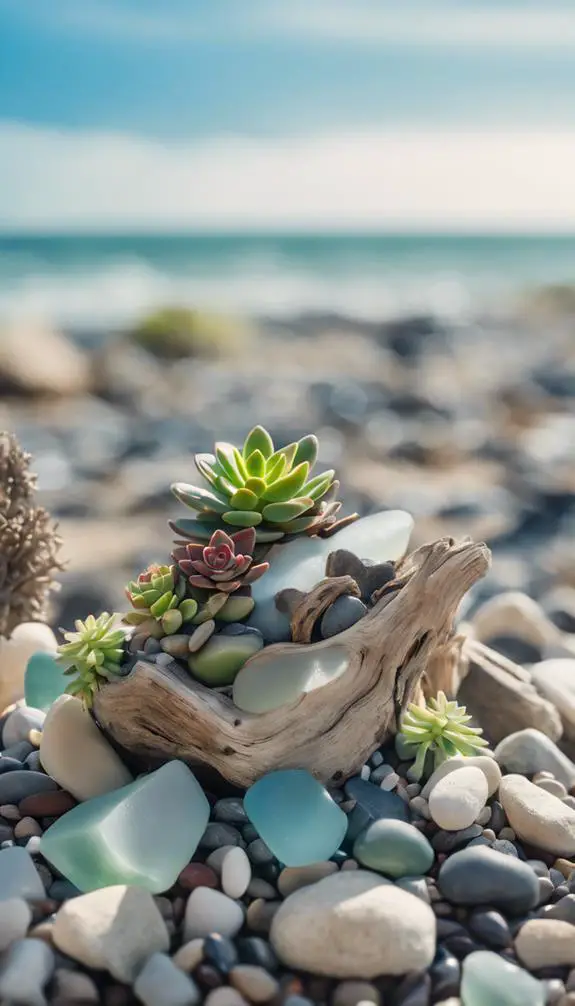
The rugged coastline, where sea spray mingles with salt-tolerant succulents, sets the stage for a unique and enchanting rock garden.
You'll create a visually striking landscape by incorporating seaside textures like weathered driftwood, pebbles, and shells.
Coastal vibes are further enhanced with succulent species that thrive in salty, windy conditions, such as sea purslane and shore succulents.
As you design your coastal succulent rock garden, consider the natural flow of the ocean's tides and incorporate gentle, curved lines to evoke a sense of movement.
Balance the ruggedness of the coastline with delicate, feathery succulents like dymondia or creeping sedum.
Whimsical Succulent Garden Accents
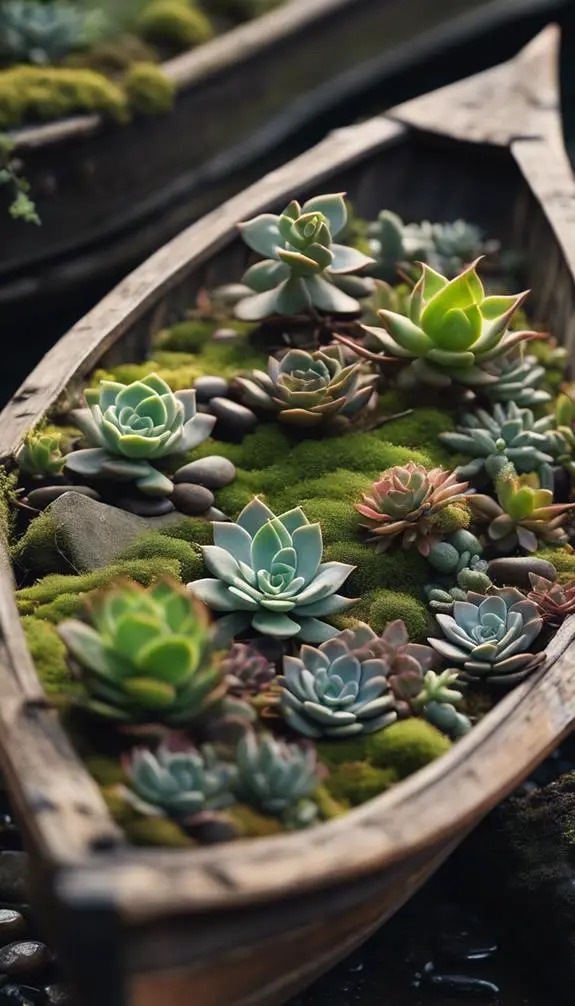
You're now ready to elevate your succulent rock garden with whimsical accents that add a touch of personality to your design.
Incorporate fairy figurines amidst the plants, creating a sense of magic and wonder. Mini sculptures, such as tiny animals or mushrooms, can also be strategically placed to add visual interest.
Consider grouping them near a focal point, like a statement succulent or a decorative rock, to draw the eye. These whimsical accents will add a touch of playfulness to your garden, making it a unique and enchanting space.
Lighting Ideas for Succulents

Sunlight filtering through the morning dew creates an ethereal ambiance in your succulent rock garden, and strategic lighting can amplify this effect.
By incorporating Solar Accents, you can highlight specific areas or plants, drawing the eye to focal points in the garden. Consider installing low-voltage pathway lights to create a warm, inviting glow or string lights to mimic the softness of moonbeams.
Moonlight Shadows can add depth and visual interest to your garden by casting dramatic shadows on the rocks and surrounding foliage. To create a truly unique ambiance, experiment with different lighting colors and intensities to evoke a range of moods and emotions.
With thoughtful lighting design, your succulent rock garden can become a mesmerizing oasis that transforms with the changing light of day.
Succulent Rock Garden Maintenance

Water conservation is crucial in a succulent rock garden, as these plants thrive in dry conditions.
You'll want to prune your succulents regularly to encourage new growth and prevent overgrowth. Remove dead or damaged leaves and stems to maintain a clean appearance and promote healthy development.
Succulent pruning also helps control the shape and size of your plants, ensuring they don't outgrow their containers. Additionally, condition your soil regularly to maintain its structure and fertility.
Add organic matter like compost or well-rotted manure to improve soil drainage and aeration. This will help your succulents absorb nutrients efficiently, leading to vibrant colors and robust growth.
Watering and Drainage Tips
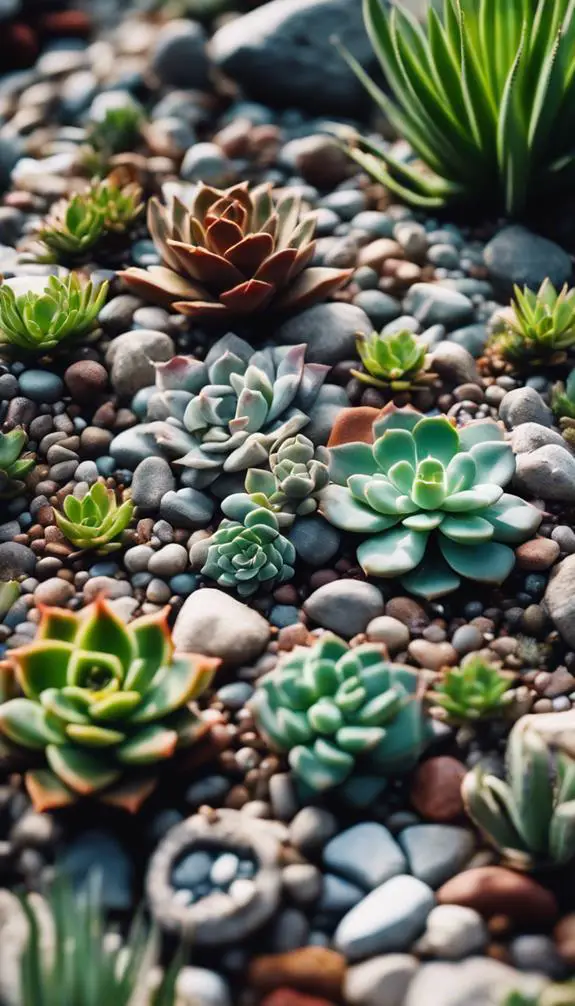
How often do you water your succulents, and are you certain you're not overwatering them?
Develop a watering schedule tailored to your climate and succulent species. Water sparingly, allowing soil to dry out completely between waterings. Avoid getting water on the leaves to prevent rot.
Implement a reliable drainage system to prevent waterlogged soil.
Use a well-draining potting mix and add a layer of small rocks or perlite at the bottom of your planters. This will guarantee excess water flows out, reducing the risk of root rot.
Create a visually appealing drainage system by incorporating decorative rocks or pebbles into your design.
DIY Succulent Rock Garden Projects

Now that you've mastered the art of watering and drainage, it's time to get creative with your succulent rock garden design.
You can elevate your succulent art by incorporating unique rock decorations. Try creating a mini succulent landscape in a shallow container, using small rocks and pebbles to create a visually appealing terrain.
You can also use larger rocks to create a statement piece, like a succulent-covered rock tower or a rock wall with succulent pockets. Add some decorative rocks or pebbles around the base of your plants to create a cohesive look.
With a little creativity, you can turn your succulent rock garden into a stunning work of art that showcases your personal style.
Frequently Asked Questions
Can Succulents Be Grown Indoors Without Direct Sunlight?
You can grow succulents indoors without direct sunlight by utilizing low light alternatives and artificial lighting options, such as LED grow lights or fluorescent lamps, which provide sufficient illumination for healthy plant growth.
How Often Should I Fertilize My Succulent Rock Garden?
When fertilizing, you'll want to strike a balance: feed your succulents during the active growing season (spring-fall) with a balanced, water-soluble fertilizer (20-20-20), taking care not to overdo it, as this can damage roots, especially in acidic soils with a pH below 6.0.
Are Succulents Susceptible to Pests and Diseases?
You'll want to monitor your plants closely, as you're not immune to pests and diseases; fungal infections can spread quickly, causing root rot, so guarantee good air circulation, water carefully, and inspect regularly to catch potential issues before they escalate.
Can I Use Regular Potting Soil for Succulents?
You'll want to avoid using regular potting soil for succulents, as it can retain too much water, causing root rot; instead, opt for soil alternatives with good drainage, and consider a pH between 6.0 and 7.0 for ideal growth.
Do Succulents Require Pruning to Maintain Shape?
You'll need to clip your succulents regularly to maintain their shape; succulent clipping is vital for shape maintenance, as it encourages bushy growth, prevents legginess, and promotes a visually appealing, compact form that's perfect for showcasing their unique beauty.
Conclusion
As you step back to admire your handiwork, remember that a thriving succulent rock garden requires attention to detail and regular maintenance. Guarantee proper watering and drainage, and prune or replace succulents as needed. With careful planning and execution, your mini-oasis will flourish, providing a serene escape from the hustle and bustle of daily life.



